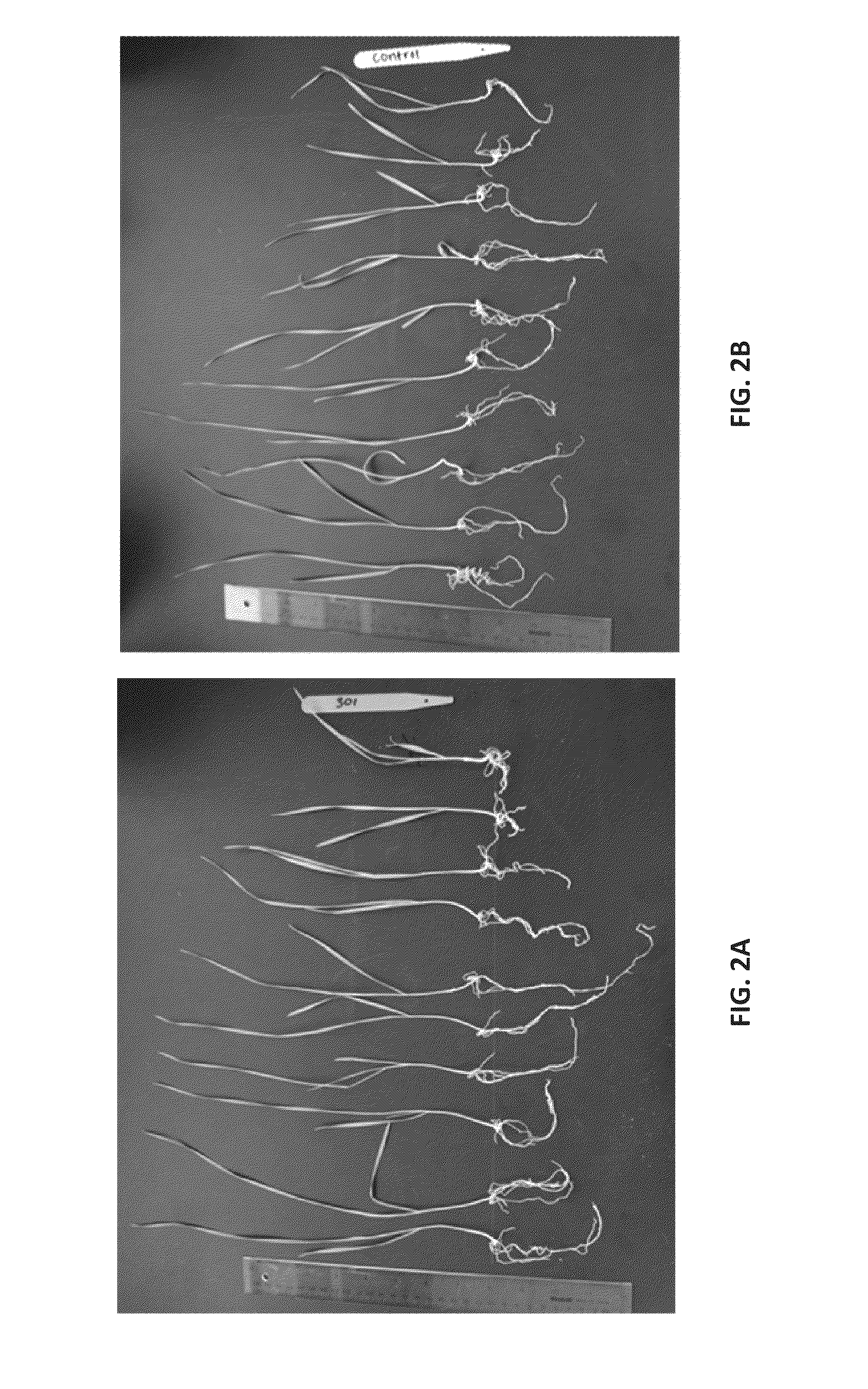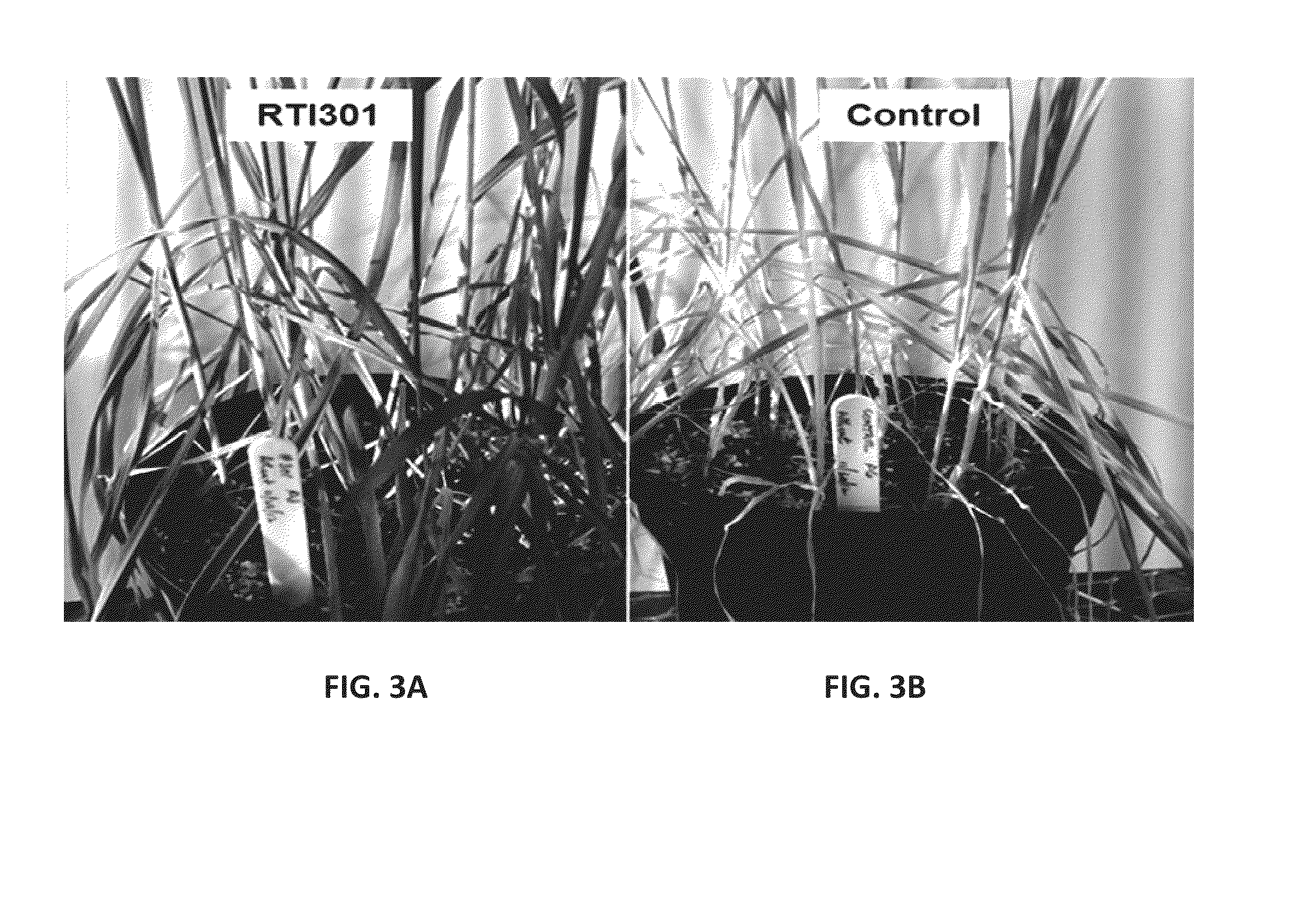Bacillus amyloliquefaciens rti301 compositions and methods of use for benefiting plant growth and treating plant disease
a technology of amyloliquefaciens and compositions, applied in the direction of biocide, waste based fuel, bacteria based processes, etc., can solve the problems of reducing the effect of bacterial resistance, reducing the amount of bacterial resistance, and reducing the use of chemical agents
- Summary
- Abstract
- Description
- Claims
- Application Information
AI Technical Summary
Benefits of technology
Problems solved by technology
Method used
Image
Examples
example 1
Identification of a Bacterial Isolate as a Bacillus Amyloliquefaciens through Sequence Analysis
[0134]A plant associated bacterial strain, designated herein as RTI301, was isolated from the rhizosphere soil of merlot vines growing at a vineyard in Long Island, N.Y. The 16S rRNA and the rpoB genes of the RTI301 strain were sequenced and subsequently compared to other known bacterial strains in the NCBI and RDP databases using BLAST. It was determined that the 16S RNA partial sequence of RTI301 (SEQ ID NO: 1) is identical to the 16S rRNA gene sequence of Bacillus amyloliquefaciens strain NS6 (KF177175), Bacillus amyloliquefaciens strain FZB42 (NR_075005), and Bacillus subtilis subsp. subtilis strain DSM 10 (NR_027552). It was also determined that the rpoB gene sequence of RTI301 (SEQ ID NO: 2) has sequence similarity to the same gene in Bacillus amyloliquefaciens subsp. plantarum TrigoCor1448 (CP007244) (99% sequence identity; 3 base pair difference); Bacillus amyloliquefaciens subsp. ...
example 2
Genes Related to Lantibiotic Biosynthesis in Bacillus Amyloliquefaciens RTI301 Strain
[0135]Further sequence analysis of the genome of the Bacillus amyloliquefaciens RTI301 strain revealed that this strain has genes related to lantibiotic biosynthesis, for which there are no homologues in the other closely related Bacillus amyloliquefaciens strains. This is illustrated in FIG. 1, which shows a schematic diagram of the genomic organization surrounding and including the lantibiotic biosynthesis operon found in Bacillus amyloliquefaciens RTI301. In FIG. 1, the top set of arrows represents protein coding regions for the RTI301 strain with relative direction of transcription indicated. For comparison, the corresponding regions for two Bacillus amyloliquefaciens reference strains, FZB42 and TrigoCor1448, are shown below the RTI301 strain. The genes in the lantibiotic synthesis operon in the RTI301 strain were initially identified using RAST and their identities then refined using BLASTp. T...
example 3
Growth Effects of Bacillus amyloliquefaciens RTI301 Isolate in Wheat
[0136]The effect of application of the bacterial isolate on early plant growth and vigor in wheat was determined. The experiment was performed by inoculating surface sterilized germinated wheat seeds for 2 days in a suspension of ˜2×107 CFU / ml of the bacterium at room temperature under aeration in the dark (a control was also performed without bacteria). Subsequently, the inoculated and control seeds were planted in 6″ pots filled with sand. 10 seeds per pot and 1 pot per treatment were planted and watered as needed alternating with water and Modified Hoagland's solution. Pots were incubated in a lab windowsill at approximately 21° C. providing natural light / dark cycles for 13 days at which point plants were recovered and parameters measured. Dry weight was determined as a total weight per 9 plants resulting in a total average dry plant weight equal to 36.1 mg for the plants inoculated with the Bacillus amyloliquefa...
PUM
| Property | Measurement | Unit |
|---|---|---|
| concentration | aaaaa | aaaaa |
| concentration | aaaaa | aaaaa |
| pH | aaaaa | aaaaa |
Abstract
Description
Claims
Application Information
 Login to View More
Login to View More - R&D
- Intellectual Property
- Life Sciences
- Materials
- Tech Scout
- Unparalleled Data Quality
- Higher Quality Content
- 60% Fewer Hallucinations
Browse by: Latest US Patents, China's latest patents, Technical Efficacy Thesaurus, Application Domain, Technology Topic, Popular Technical Reports.
© 2025 PatSnap. All rights reserved.Legal|Privacy policy|Modern Slavery Act Transparency Statement|Sitemap|About US| Contact US: help@patsnap.com



